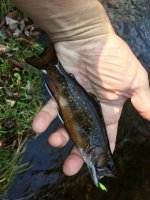Out4Trout
Member
- Joined
- Nov 29, 2017
- Messages
- 182
Dont know why it took me so long to learn about this fly but it sure does catch the brookies here in the Poconos. I just started tying a few months ago and this is a great fly to start with. Catching so many fish on it is a bonus. What are your thoughts on the Green Weenie? I think Im gonna try it in a few other colors like pink or red.
Caught this one today in a local stream along with 4 or 5 others all in about 30 minutes. I found dead drifting this fly seems to work best right now.
Caught this one today in a local stream along with 4 or 5 others all in about 30 minutes. I found dead drifting this fly seems to work best right now.





